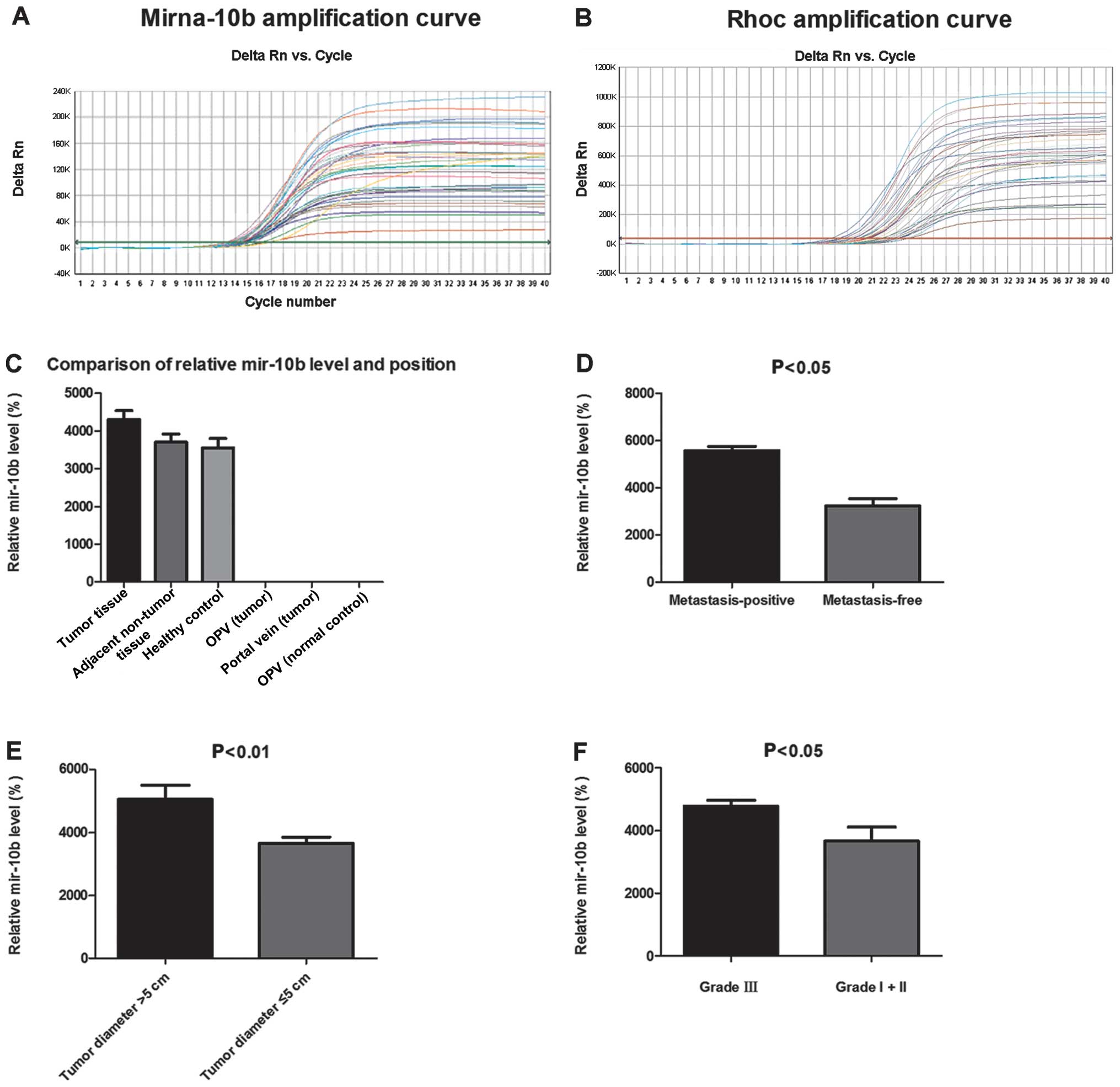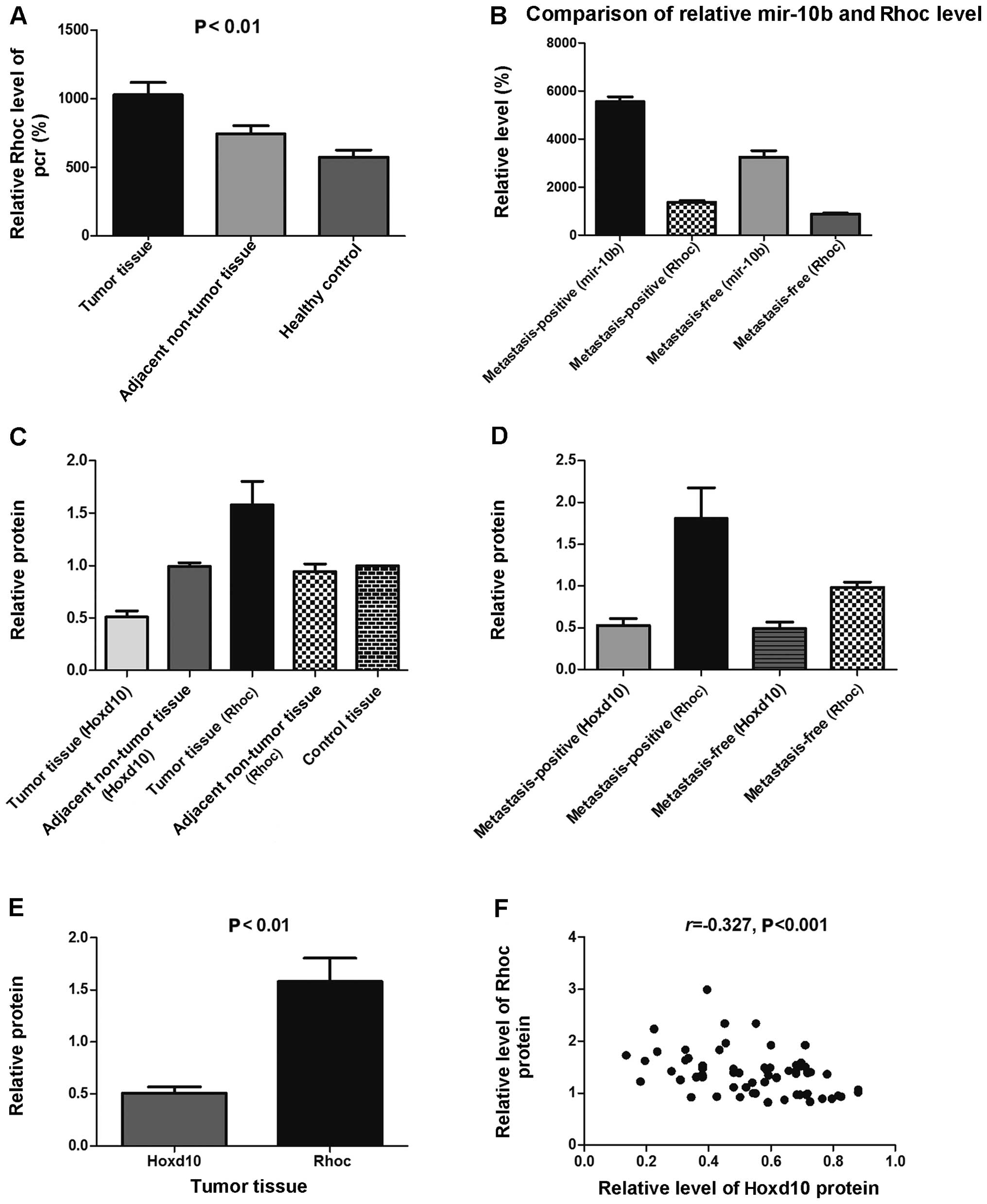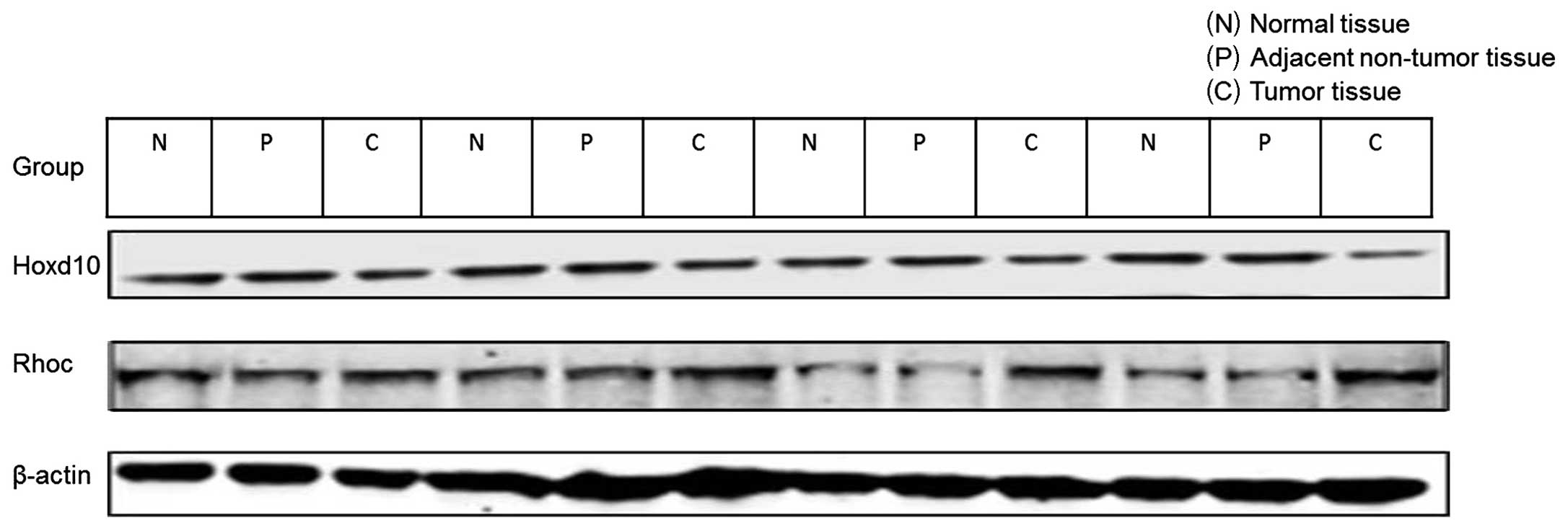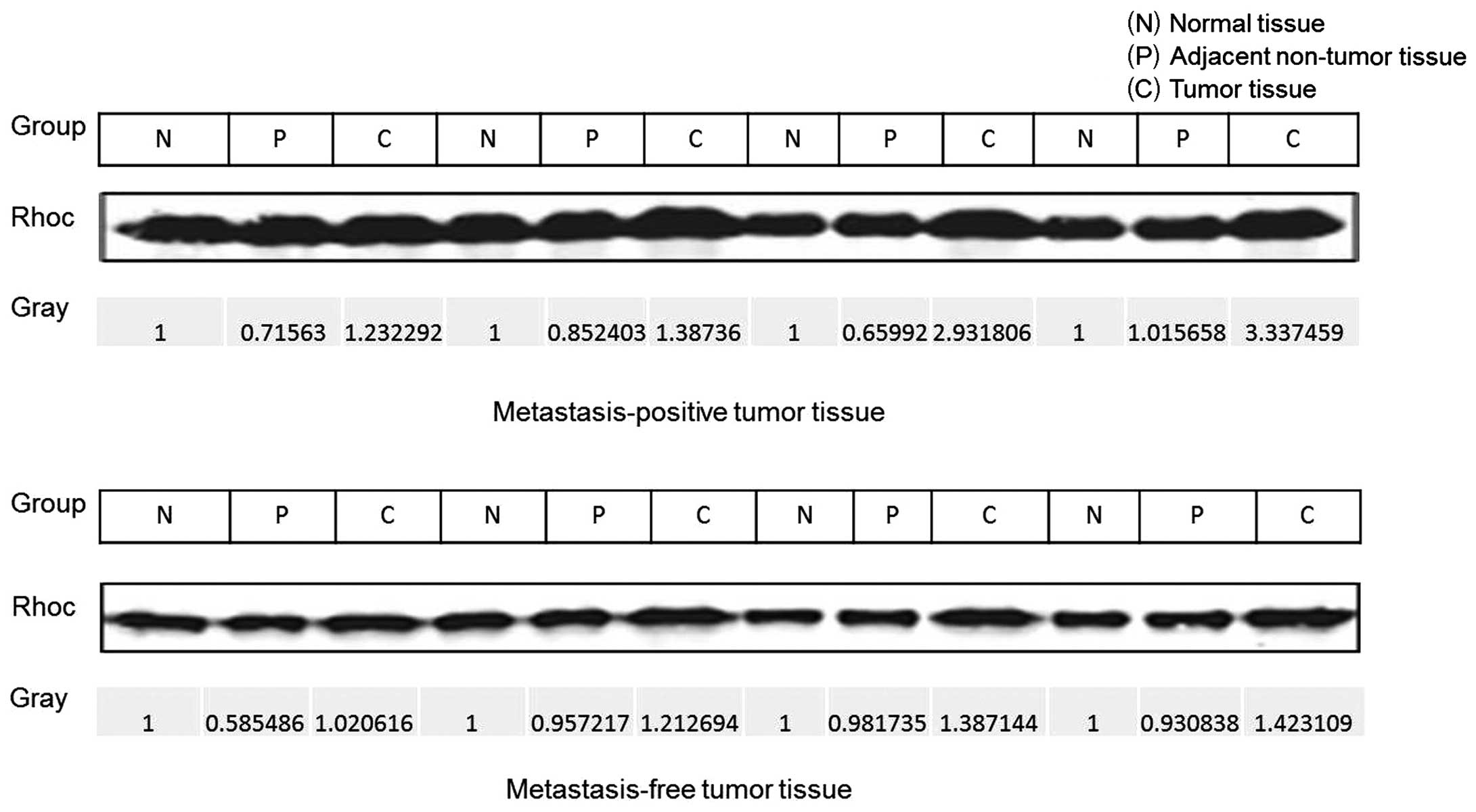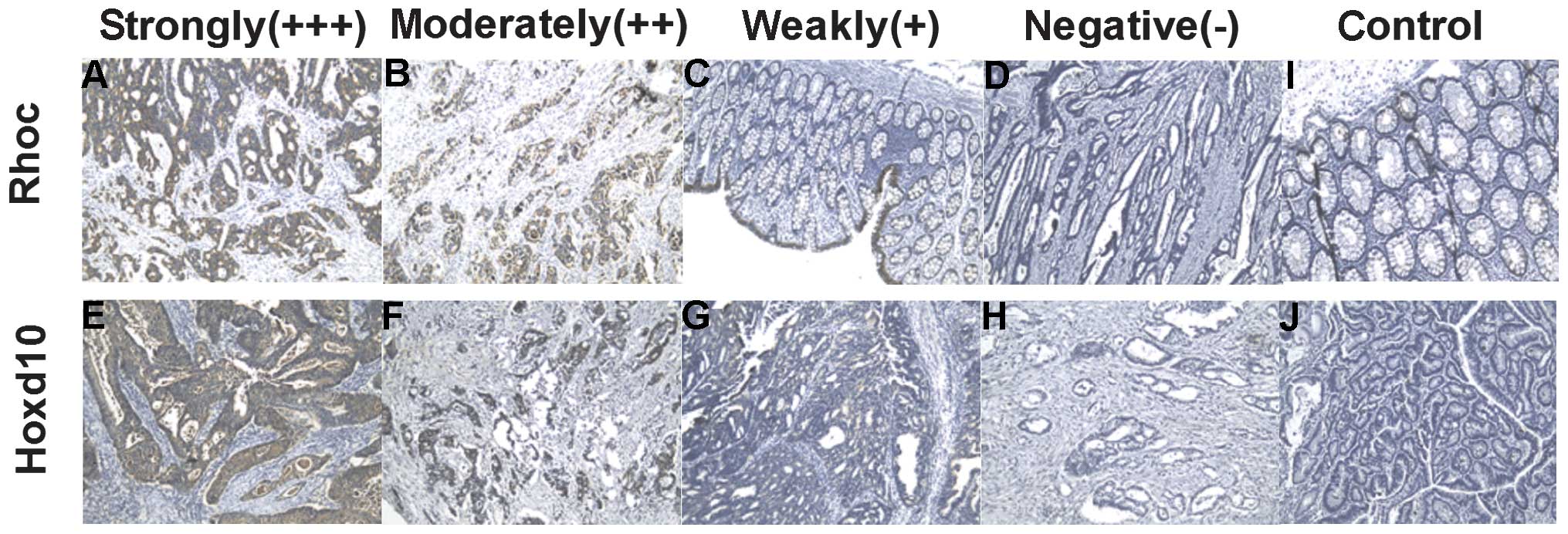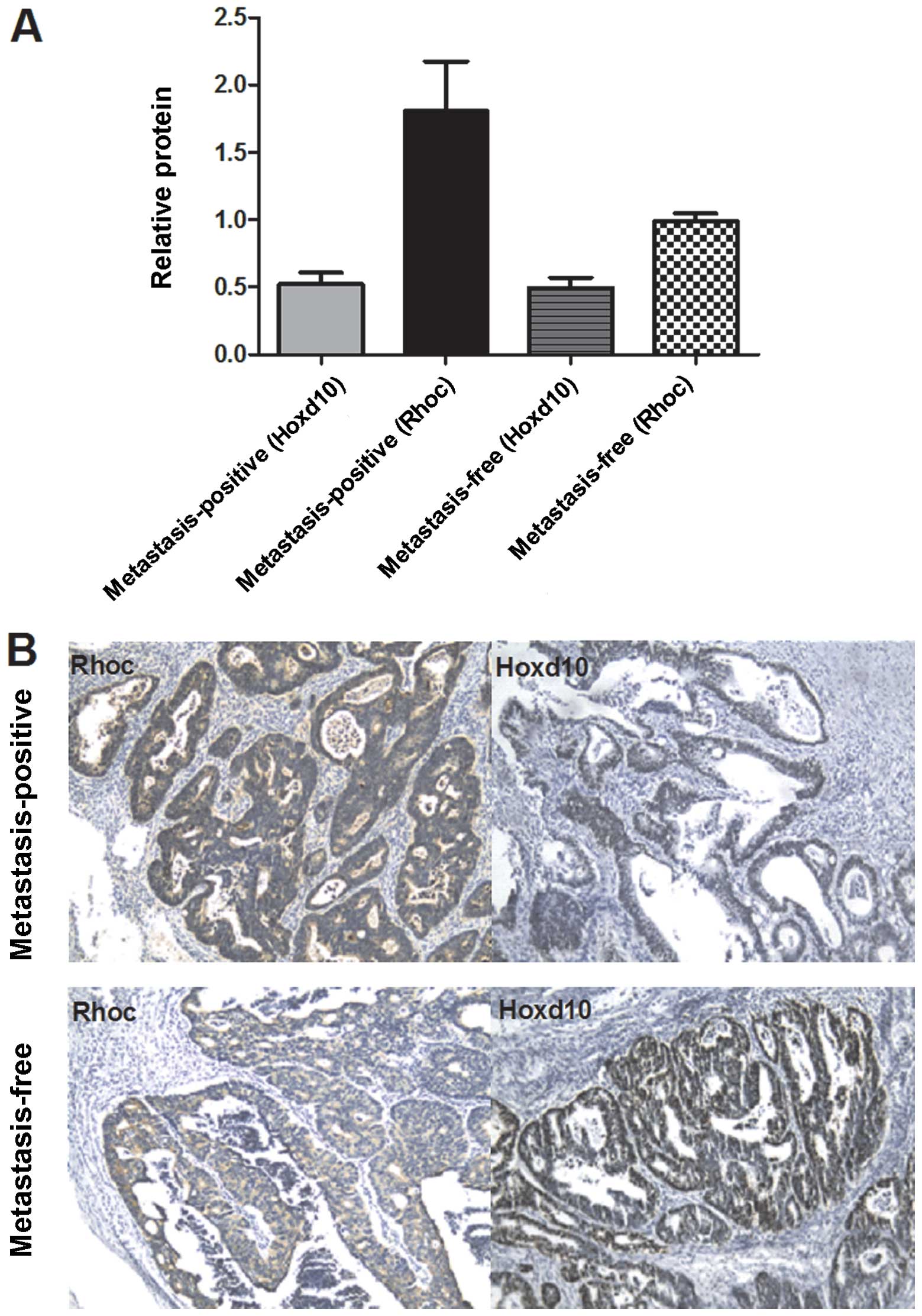MicroRNA-10b is upregulated and has an invasive role in colorectal cancer through enhanced Rhoc expression
- Authors:
- Published online on: January 20, 2015 https://doi.org/10.3892/or.2015.3737
- Pages: 1275-1283
Abstract
Introduction
Colorectal cancer (CRC) is the third most common type of cancer, and is a common gastrointestinal tumor. Malignant colorectal cancer cells often possess the ability of rapid progression and invasion, which contributes to tumor metastasis (1,2). The mechanism of invasion is complex and involves integrated biochemical processes requiring a coordinated effort in managing a number of intracellular and extracellular interactions. Tumor cells achieve this by excessive production of several proteases and by modifying the extracellular matrix (ECM). In addition, members of the Ras superfamily of GTPases, most notably the Rho proteins, play a prominent role in cell migration (3,4). Therefore, the development of more effective treatments for the inhibition of invasion and metastasis is required in patients with advanced CRC.
The miR-10b gene is located in the middle of the Hoxd cluster on chromosome 2q31, near Hoxd4. This miRNA proceeds to inhibit the translation of Hoxd10, resulting in the increased expression of a well-characterized prometastatic gene, Rhoc. Hoxd10 belongs to the HOX gene family, and its expression is lost during the malignant progression of breast cancer (5). Besides breast cancer, an aberrant expression pattern of miR-10b has also been reported in hepatocellular carcinoma, and higher-grade glioma, unlike that in case of benign tumors (6,7). The silencing of miR-10b significantly decreases miR-10b levels and increases the levels of Hoxd10, which in turn inhibits metastasis (8,9). The conserved 3′UTR element of Hoxd10-encoded mRNA is partially complementary to miR-10b, by which miR-10b abrogates the function of Hoxd10 by inhibiting protein translation but not mRNA degradation (10). Rhoc was reported to promote tumor metastasis in distinct carcinomas by stimulating the activity of a series of kinases including protein kinase B (AKT) and mitogen-activated protein kinase (MAPK) (11,12). AKT mediates various basic cell processes such as apoptosis and the cell cycle (13,14). Abnormal AKT signaling has been found to be associated with tumor metastasis.
The effect of miR-10b on the metastasis of colorectal cancer and the related molecular mechanism remains unclear. However, whether the overexpression of miR-10b is involved in colorectal cancer remains to be investigated. Therefore, we examined the expression level of miR-10b in 70 cases of colorectal cancer and found that miR-10b was upregulated in all the cases, unlike that in the case of the non-tumor tissue. Furthermore, we found that miR-10b overexpression in colorectal cancer led to decreased protein levels of Hoxd10, and increased Rhoc expression, both of which were critical to miR-10b-induced invasion. In addition, the overexpression of miR-10b was highly associated with higher-grade colorectal cancer. From these findings, it is possible to postulate that miR-10b plays a role in the invasion of colorectal cancer, and may therefore be a highly attractive target for novel molecular monotherapy or combination therapy for colorectal cancer.
Materials and methods
Ethics and tumor specimen acquisition
This study was performed in compliance with the Helsinki Declaration and according to the protocol approved by the Medical Ethics Committee of the Yangpu Hospital affiliated to Shanghai Tongji University. All the subjects were informed of the study and volunteered to participate there in. Written informed consent was obtained from all patients and participants.
Study population
The study involved 70 patients with histologically confirmed primary colorectal cancer, who had undergone surgical resection at the Department of General Surgery at the Yangpu Hospital affiliated to Shanghai Tongji University. Seventy healthy individuals who had undergone physical examination in the same hospital from 1, January 2013 to 1, January 2014 were also enrolled in the study. The 70 colorectal cancer patients had an age range of 43–86 years, with a mean age of 62.8±11.6 years. There were no other inclusion or exclusion criteria. The patients did not receive any preoperative radiotherapy and/or chemotherapy, and the diagnosis was confirmed by pathologic analysis. All the patients were staged according to the tumor, node and metastasis (TNM) staging system of the American Joint Committee on Cancer (AJCC) and International Union Against Cancer (UICC) for colorectal cancer (2010 seventh edition). The clinical and pathological profiles of the patients are provided in Table I. The 70 healthy individuals included 33 men and 37 women with a mean age of 60.6±7.6 years (range, 38–76 years).
Collection of tumor specimens, serum samples, and preparation of total RNA
Colorectal cancer tissues were obtained from therapeutic procedures performed as routine clinical management at our institution. All the tissue samples were obtained at the time of operation. Tissue samples were resected during surgery and immediately frozen in liquid nitrogen for subsequent total RNA extraction. Blood samples were collected in sterile tubes, centrifuged at 2,000 × g for 10 min at room temperature, and the supernatant serum was collected and preserved at −80°C until further use.
RT-qPCR for miR-10b
Total RNA was isolated using TRIzol® reagent (Invitrogen Life Technologies, Grand Island, NY, USA), according to the manufacturer’s instructions. cDNA was synthesized using the Reverse Transcriptase kit (Thermo Scientific, Shanghai, China), as described by the manufacturer. Expression of miR-10b was analyzed using the SYBR-Green PCR kit (Thermo Scientific), according to the manufacturer’s instructions. Small nuclear 5S RNA was used for normalization. The primers used for detecting miR-10b were as follows: miR-10b reverse transcription primer: forward, 5′-TACCCTGTAGAACCGAATTTG-3′, and reverse, 5′-AACTGGTGTCGTGGAGTCGGC-3′ (Jrdun Biotechnogy, Shanghai, China). These primers used for 5S RNA (QIR) were: forward, 5′-CCATACCACCCTGGAAACGC-3′ and reverse, 5′-TACTAACCGAGCCCGACCCT-3′. The PCR reaction was conducted at 95°C for 10 sec, followed by 40 cycles of 95°C for 15 sec and 60°C for 45 sec, annealing at 95°C for 15 sec, 60°C for 1 min, 95°C for 15 sec and 60°C for 15 sec in a 7500 Fast Real-Time PCR System (Power SYBR-Green PCR Master Mix). A template-free reaction was used as a negative control. Each sample was run in triplicate. Expression levels were calculated by the ΔCt method using the Applied Biosystems 7500 Fast Real-Time PCR System SDS software, version 1.2.
RT-qPCR for Rhoc
Total RNA was isolated using TRIzol® reagent (Invitrogen Life Technologies), and reverse transcription was performed using a Reverse Transcriptase kit (Thermo Scientific), according to the manufacturer’s instructions. Glyceraldehyde 3-phosphate dehydrogenase (GAPDH; Life Technologies) was used as the endogenous control. Expression of Rhoc was analyzed using the SYBR-Green Mix (Thermo Scientific). The primers used for detecting Rhoc mRNA were: forward, 5′-GGAGGTCTACGTCCCTACTGT-3′ and reverse, 5′-CGCAGTCGATCATAGTCTTCC-3′. The primers used for detecting GAPDH were: forward, 5′-GGAGCGAGATCCCTCCAAAAT-3′ and reverse, 5′-GGCTGTTGTCATACTTCTCATGG-3′. Reaction mixtures were incubated for an initial denaturation at 95°C for 10 min followed by 40 cycles of 95°C for 15 sec and 60°C for 45 sec, annealing at 95°C for 15 sec, 60°C for 1 min, 95°C for 15 sec and 60°C for 15 sec. Each sample was run in triplicate. Fold-change (relative copy number) was obtained and analyzed by the ΔCt method by using the Applied Biosystems 7500 Fast Real-Time PCR System SDS software, version 1.2.
Western blot analysis
Tissue samples were lysed in RIPA lysis buffer (150 mM NaCl, 10 mM Tris-HCl, pH 7.5, 1% NP-40, 1% deoxycholate, 0.1% SDS, and protease inhibitor cocktail). Proteins from total tissue sample lysates were analyzed using NuPAGE 4–12% Bis-Tris gradient gels (Invitrogen) and transferred onto PVDF membranes, which were blocked in Tris-buffered saline (TBS) plus 0.1% Tween-20 (TTBS) and 5% non-fat dry milk. The membranes were blotted using antibodies for Rhoc and Hoxd10 (dilution, 1:200) (Abcam, Shanghai, China) and β-actin (dilution, 1:10,000), and developed with secondary antibody anti-goat IgG HRP (dilution, 1:10,000). BCA was used for protein quantification. Signals were detected using an ECL Prime Western Blotting Detection kit (GE Healthcare, Buckinghamshire, UK). Immunoreactive signal intensities were analyzed using the Image J software (NIH, Bethesda, MD, USA).
Immunohistochemistry
Sections (4 μm) were cut from formalin-fixed, paraffin-embedded samples, and stained with hematoxylin and eosin. These samples were reviewed by experienced pathologists. The primary antibody used for Rhoc immunostaining was a rabbit anti-Rhoc polyclonal antibody (Abcam), and for Hoxd10 immunostaining, a goat polyclonal anti-Hoxd10 antibody (Abcam). The sections were incubated with HRP-conjugated anti-rabbit IgG polyclonal secondary antibody (Abcam) for 45 min, and the reaction products were visualized by immersing the sections in 0.03% diaminobenzidine solution containing 2 mM hydrogen peroxide for 1–5 min. Nuclei were lightly stained with Mayer’s hematoxylin. For control studies of the antibodies, serial sections were treated with phosphate-buffered saline, and a normal goat IgG monoclonal antibody (Abcam) was used instead of the primary antibodies. These were confirmed to be unstained. Quantitative comparative analysis of immunohistochemical staining was carried out in each case. Two independent pathologists performed quantitative assessment of the immunohistochemical staining. Staining in nuclei was graded as follows: 0, no immunoreactive cells evident; 1, proportion of immunoreactive cells <20%; 2, 20–70%; 3, >70%. Immunohistochemical reactivity was evaluated and classified into the groups: 1, negative (−); 2, weakly positive (+); 3, moderately positive (++); 4, strongly positive (+++).
Statistical analysis
Data were expressed as mean ± SD. Measurement data between groups were compared with the t-test (two-tailed), while enumeration data were compared using the χ2 test. The correlation between miR-10b and mRNA levels of Rhoc and Hoxd10 was assessed using Spearman’s rank test. Differences between two groups for immunostaining were analyzed using the Mann-Whitney U test. Statistical analyses were performed using the SPSS® statistical package, version 17.0 (SPSS Inc., Chicago, IL, USA) for Windows®. P<0.05 was considered statistically significant.
Results
Expression level of miR-10b in colorectal cancer
Quantitative RT-PCR (RT-qPCR) successfully amplified miR-10b in clinical specimens and serum samples (Fig. 1A). Quantitative miRNA expression data were analyzed by the ΔCt method. The level of miR-10b in colorectal cancer tissue was significantly higher compared with the level of sera of patients and healthy controls (P=0.009, P=0.026, respectively) (Fig. 1C). There were significant differences in the mean miR-10b level between the colorectal cancer tissue group and the adjacent non-tumor tissues and healthy control tissues groups (P<0.05) (Table II). No statistical significance was identified between the adjacent non-tumor tissue group and the control tissue group (P>0.05). However, significant differences in the mean miR-10b level between the healthy control outer periphery vein group and the other two groups (P<0.05) was observed, whereas no statistical significance was identified between the outer periphery vein group and the portal vein group in colorectal cancer (P>0.05). There was no significant difference in miR-10b levels with respect to age (P>0.05) (Table III).
Table IIIVariation in miR-10b levels according to clinicopathological factors analyzed using the t-test with Bonferroni correction. |
Colorectal cancer patients were sub-classified for clinicopathological characteristics according to tumor stage, size, and histological differentiation for the calculation of miR-10b levels. The expression level of miR-10b was markedly elevated in lymph node metastasis-positive tumor tissue compared with lymph node metastasis-free tumor tissue (Fig. 1D). The results showed that there were significant differences in miR-10b levels between the colorectal cancer cases with regard to tumor size (Fig. 1E and Table III). MiR-10b expression was also significantly different between stage I+II and III tumors (P<0.05) (Fig. 1F). There were significant differences in miR-10b levels in cases of liver metastases and multifocal with other tumor case (P<0.05) (Table I).
Correlation between miR-10b with mRNA expression of Rhoc
Sasayama et al (20) have shown that miR-10b inhibits the translation of Hoxd10 mRNA. Two effectors of Hoxd10 are Rhoc and uPAR, which are involved in invasion, migration, and metastasis (15–17). Therefore, we examined the mRNA expression of Rhoc in colorectal cancer tissue using RT-qPCR, which was successfully amplified in samples from clinical specimens (Fig. 1B). There were significant differences in the mean Rhoc mRNA level between the colorectal cancer tissue group and the other two groups (P<0.01) (Fig. 2A). The difference was also significant between the adjacent non-tumor tissue group and the control tissue group (P=0.03). There were significant positive correlations between miR-10b and mRNA expression of Rhoc (r=0.695, P<0.001). The levels of miR-10b and Rhoc mRNA were markedly elevated in lymph node metastasis-positive tumor tissue compared with lymph node metastasis-free tumor tissue (Fig. 2B).
Western blot analysis of the protein expression of Hoxd10 and Rhoc
Rhoc protein expression can enhance tumor cell invasiveness and metastasis. We therefore determined whether miR-10b inhibits the translation of Hoxd10 mRNA, thereby affecting the expression of the upstream targets of Rhoc. Our results showed that miR-10b reduced Hoxd10 and increased Rhoc protein expression (Figs. 2C and 3). The expression level of Hoxd10 and Rhoc in colorectal cancer tissue was significantly different when compared with that in the control tissue (P<0.01 and P=0.026, respectively), while there was no statistical significance between the adjacent non-tumor tissue group and the control tissue group (P=0.863 and P=0.448, respectively). Rhoc protein levels were markedly elevated in lymph node metastasis-positive tumor tissue as compared to that in the lymph node metastasis-free tumor tissue (P<0.01) (Figs. 2D and 4). The Spearman’s rank correlation test showed that there was a high negative correlation between Rhoc level and Hoxd10 protein level (−0.3<r<−0.5, P<0.001) (Fig. 2E and F).
Correlation between miR-10b with the protein expression of Hoxd10 and Rhoc
To examine the correlation between miR-10b and the protein expression of Hoxd10 and Rhoc, immunohistochemical analysis was performed. Immunohistochemical reactivity was evaluated and classified as: negative (−), weak (+), moderate (++), and strong (+++), (Fig. 5). All the samples were further classified into two groups based on the levels of miR-10b: samples showing >25-fold relative expression of miR-10b were defined as the high miR-10b expression group. Of the 47 cases in the high miR-10b expression group, moderate and strong expressions of Rhoc protein were observed in 23 (48.9%) and 11 (23.4%) cases, respectively. On the other hand, in the low miR-10b expression group, moderate and strong expressions of Rhoc protein were observed in 7 (30.4%) and 0 (0%) of 23 cases, respectively. Rhoc protein expression in the miR-10b high expression group was significantly higher than that in the low expression group (P<0.001, Mann-Whitney U test). In addition, of the 47 high miR-10b expression samples, moderate and strong expressions of Hoxd10 were found in 8 (17%) and 0 (0%) cases, respectively, whereas, in the low miR-10b expression group, there were 10 (43.5%) and 2 (8.7%) cases, respectively, (Table IV). There was a statistically significant difference between high and low miR-10b expression groups in Hoxd10 immunostaining (P<0.001, Mann-Whitney U test). A significant inverse correlation between the immunoreactivity of Hoxd10 and Rhoc was observed (Table IV). Tumor samples were collected and sorted into two groups: those that were lymph node metastasis-free and those that were lymph node metastasis-positive. Results of the western blot analysis indicated that Rhoc levels in tumor tissue from the metastasis-positive group were 1-to 2-fold higher than those of the metastasis-free tissue (Fig. 6A). To confirm the western blot analysis data, we performed immunohistochemistry to detect the levels of Rhoc. We found that Rhoc immunoexpression was enhanced in metastasis-positive tissue, unlike that in the case of the metastasis-free tissue. A significant inverse immunoreactivity of Hoxd10 was observed (Fig. 6B). These data revealed that Rhoc may be involved in the process of colorectal cancer metastasis.
Discussion
We found increased serum concentrations of miR-10b in patients with colorectal cancer, unlike that in the case of the healthy controls. The outer periphery and portal vein serum miR-10b concentration levels were not significantly different in colorectal cancer (t=1.620, P=0.110). There was a significant difference in the mean level of miR-10b in tumor tissue compared with the control tissue (t=−2.133, P=0.038), and with adjacent non-tumor tissues (t=−2.179, P=0.033). However, miR-10b concentration levels were not significantly different between the adjacent non-tumor tissues and the control tissues (t=0.496, P=0.621) (Table II and Fig. 1C). Moreover, there was a significant difference in the mean level of miR-10b in tissues in serum of colorectal cancer (P<0.01). The results also showed that there were significant differences in miR-10b levels between colorectal cancer cases of different stages, tumor sizes, node status, but that the differences concerning age, gender, and differentiations were not significantly different (Table III). MiR-10b levels were markedly elevated in lymph node metastasis-positive tumor tissue compared with lymph node metastasis-free tumor tissue (Fig. 1D). In addition, there was a statistically significant difference between the multifocal and single cases (P=0.04) (Table I). Serum miR-10b concentrations were significantly higher in colorectal cancer patients than in healthy control subjects in the present study (P<0.01). This finding is in accordance with studies that have reported elevated miR-10b concentrations in breast cancer. The results of the present study suggest that miR-10b is worthy of further evaluation as a prognostic marker in colorectal cancer, although its molecular mechanism requires further investigation.
As one of the gene targets of miR-10b, Hoxd10 is considered the main effector that negatively regulates tumor metastasis (18). In the present study, miR-10b was highly expressed, accompanied by increased Rhoc levels in colorectal cancer (Fig. 1B, Fig. 2A and B). The expression level of Hoxd10 and Rhoc in colorectal cancer tissue was significantly different compared with that of the control tissue (P<0.01, P=0.026, respectively), and with the adjacent non-tumor tissue group (P<0.01 and P=0.018, respectively; Fig. 2C). However, there was no statistically significant difference between the adjacent non-tumor tissue group and the control tissue group (P=0.863 and P=0.448, respectively). Rhoc protein levels were markedly elevated in lymph node metastasis-positive tumor tissue compared with lymph node metastasis-free tumor tissue (P<0.01) (Figs. 2D and 4). The Spearman’s rank correlation test showed that there was a high negative correlation between Rhoc and Hoxd10 protein levels (Fig. 2F and 3). Consistent with previous findings that miR-10b was able to drive tumor metastasis (10), high levels of miR-10b were detected in colorectal cancer, with a low degree of differentiation that possesses a strong ability of metastasis. Hoxd10 has been known to repress the expression of genes involved in tumor metastasis including Rhoc. There was a statistically significant difference between high and low miR-10b expression groups in Rhoc and Hoxd10 immunostaining (P<0.001, Mann-Whitney U test). A significant inverse correlation between the immunoreactivity of Hoxd10 and that of Rhoc was observed (Table IV and Fig. 5). MiR-10b overexpression led to the elevation of Rhoc, which indicates that Rhoc contributes to miR-10b-induced invasiveness with the target gene of Hoxd10. Rhoc expression was found to be attenuated in lowly differentiated and lymph node metastasis-positive colorectal cancer compared with those in well-differentiated and metastasis-free lymph nodes (Figs. 2D, 4 and 6). These results suggest that miR-10b reduces the threshold of metastasis in colorectal cancer as the positive regulator, which is inversely related to Hoxd10.
Significantly higher concentrations of tissue and serum miR-10b were identified in patients with colorectal cancer than those in the adjacent non-tumor tissues and healthy control subjects. The concentrations of miR-10b increased as the clinical stage progressed. These results suggest miR-10b is involved in the development of colorectal cancer, and may be a new therapeutic target. In the present study, we found that miR-10b has a critical role in colorectal cancer cell invasion. Overexpression of miR-10b led to increased Rhoc by targeting Hoxd10, which facilitates cell invasion in colorectal cancer. Furthermore, miR-10b expression in high-grade colorectal cancer with multifocal lesions was statistically significant and higher than that in cancer with single lesions. These findings indicate that miR-10b may play a role in the invasion and migration of colorectal cancer. Ma et al (19) identified miR-10b as a highly expressed miRNA in metastatic breast tumors that promotes cell migration and invasion. It has also been shown to inhibit the translation of mRNA encoding Hoxd10, which modulates many genes, including uPAR (20), Rhoc (21), α3 (22), integrin (23), β integrin (24) and MMP-14 (25,26), which promote invasion, migration, ECM remodeling, and tumor progression (27). In addition, TWIST, a well-known transcriptional factor related to EMT, activates the transcription of miR-10b by binding directly to an E-box sequence proximal to its putative promoter (28). Although miR-10b does not trigger EMT by itself, it may be required for TWIST-induced cell motility and invasiveness in cancer cells (29).
Rhoc has been identified as an especially important player in metastasis, and its expression correlates with the metastatic spread of various types of carcinomas (30–32). In our study, the expression of Rhoc correlated with the expression levels of miR-10b, and a significant inverse correlation between the immunoreactivity of Hoxd10 and Rhoc was observed.
In conclusion, our study suggests that high levels of miR-10b are associated with the degree of metastasis in colorectal cancer patients. A high expression of Rhoc and downregulation of Hoxd10 correlated with the expression levels of miR-10b. These results indicate that miR-10b may play a role in invasion in colorectal cancer. In addition, miR-10b overexpression promoted the invasiveness of colorectal cancer by targeting Hoxd10, which partially passed through Rhoc-AKT signaling. These observations shed new light on the mechanisms underlying the invasion of colorectal cancer and provide novel therapeutic targets in inhibiting metastasis. Moreover, studies using clinical samples are necessary to clarify whether the quantification of miR-10b in peripheral blood may be applied as a biomarker of colorectal cancer.
Acknowledgements
This study was supported by grants from youth issues of the Shanghai Municipal Health Bureau of China (20124y155).
References
|
Walker AS, Zwintscher NP, Johnson EK, et al: Future directions for monitoring treatment response in colorectal cancer. J Cancer. 5:44–57. 2014. View Article : Google Scholar : PubMed/NCBI | |
|
Manser CN and Bauerfeind P: Impact of socioeconomic status on incidence, mortality, and survival of colorectal cancer patients: a systematic review. Gastrointest Endosc. 80:42–60. 2014. View Article : Google Scholar : PubMed/NCBI | |
|
Chi X, Wang S, Huang Y, et al: Roles of rho GTPases in intra-cellular transport and cellular transformation. Int J Mo Sci. 28:7089–7108. 2013. View Article : Google Scholar | |
|
Chu E: Personalized medicine and anti-EGFR antibody therapy in the treatment of metastatic colorectal cancer: KRAS and beyond. Oncology. 28:962014.PubMed/NCBI | |
|
Yu X, Li Z, Shen J, et al: MicroRNA-10b promotes nucleus pulposus cell proliferation through RhoC-Akt pathway by targeting HOXD10 in intervetebral disc degeneration. PLoS One. 8:e830802013. View Article : Google Scholar : | |
|
Lang MF, Yang S, Zhao C, et al: Genome-wide profiling identified a set of miRNAs that are differentially expressed in glioblastoma stem cells and normal neural stem cells. PLoS One. 7:e362482012. View Article : Google Scholar : PubMed/NCBI | |
|
Preis M, Gardner TB, Gordon SR, et al: MicroRNA-10b expression correlates with response to neoadjuvant therapy and survival in pancreatic ductal adenocarcinoma. Clin Cancer Res. 17:5812–5821. 2011. View Article : Google Scholar : PubMed/NCBI | |
|
Xiao H, Li H, Yu G, et al: MicroRNA-10b promotes migration and invasion through KLF4 and HOXD10 in human bladder cancer. Oncol Rep. 31:1832–1838. 2014.PubMed/NCBI | |
|
Schepeler T, Reinert JT, Ostenfeld MS, et al: Diagnostic and prognostic microRNAs in stage II colon cancer. Cancer Res. 68:6416–6424. 2008. View Article : Google Scholar : PubMed/NCBI | |
|
Liu Z, Zhu J, Cao H, et al: MiR-10b promotes cell invasion through RhoC-AKT signaling pathway by targeting HOXD10 in gastric cancer. Int J Oncol. 40:1553–1560. 2012.PubMed/NCBI | |
|
Malissein E, Meunier E, Lajoie-Mazenc I, et al: RhoA and RhoC differentially modulate estrogen receptor α recruitment, transcriptional activities, and expression in breast cancer cells (MCF-7). J Cancer Res Clin Oncol. 139:2079–2088. 2013. View Article : Google Scholar : PubMed/NCBI | |
|
Zhao Y, Zheng HC, Chen S, et al: The role of RhoC in ovarian epithelial carcinoma: a marker for carcinogenesis, progression, prognosis, and target therapy. Gynecol Oncol. 130:570–578. 2013. View Article : Google Scholar : PubMed/NCBI | |
|
Goundiam O, Nagel MD and Vayssade M: Akt and RhoA inhibition promotes anoikis of aggregated B16F10 melanoma cells. Cell Biol Int. 36:311–319. 2012. View Article : Google Scholar | |
|
Gao W, Dong X, Xie N, et al: Dehydroabietic acid isolated from Commiphora opobalsamum causes endothelium-dependent relaxation of pulmonary artery via PI3K/Akt-eNOS signaling pathway. Molecules. 19:8503–8517. 2014. View Article : Google Scholar : PubMed/NCBI | |
|
Han X, Yan S, Weijie Z, et al: Critical role of miR-10b in transforming growth factor-β1-induced epithelial-mesenchymal transition in breast cancer. Cancer Gene Ther. 21:60–67. 2014. View Article : Google Scholar : PubMed/NCBI | |
|
Parrella P, Barbano R, Pasculli B, et al: Evaluation of microRNA-10b prognostic significance in a prospective cohort of breast cancer patients. Mol Cancer. 13:1422014. View Article : Google Scholar : PubMed/NCBI | |
|
Severino P, Brüggemann H, Andreghetto FM, et al: MicroRNA expression profile in head and neck cancer: HOX-cluster embedded microRNA-196a and microRNA-10b dysregulation implicated in cell proliferation. BMC Cancer. 13:5332013. View Article : Google Scholar : PubMed/NCBI | |
|
Fu Y, Li F, Zhao DY, et al: Interaction between Tbx1 and Hoxd10 and connection with TGFβ-BMP signal pathway during kidney development. Gene. 536:197–202. 2014. View Article : Google Scholar | |
|
Ma L, Teruya-Feldstein J and Weinberg RA: Tumour invasion and metastasis initiated by microRNA-10b in breast cancer. Nature. 449:682–688. 2007. View Article : Google Scholar : PubMed/NCBI | |
|
Sasayama T, Nishihara M, Kondoh T, et al: MicroRNA-10b is over-expressed in malignant glioma and associated with tumor invasive factors, uPAR and RhoC. Int J Cancer. 125:1407–1413. 2009. View Article : Google Scholar : PubMed/NCBI | |
|
Nakayama I, Shibazaki M, Yashima-Abo A, et al: Loss of HOXD10 expression induced by upregulation of miR-10b accelerates the migration and invasion activities of ovarian cancer cells. Int J Oncol. 43:63–71. 2013.PubMed/NCBI | |
|
Carrio M, Arderiu G, Myers C and Boudreau NJ: Homeobox D10 induces phenotypic reversion of breast tumor cells in a three-dimensional culture model. Cancer Res. 65:7177–7185. 2005. View Article : Google Scholar : PubMed/NCBI | |
|
Xu B, Geerts D, Bu Z, et al: Regulation of endometrial receptivity by the highly expressed HOXA9, HOXA11 and HOXD10 HOX-class homeobox genes. Hum Reprod. 29:781–790. 2014. View Article : Google Scholar : PubMed/NCBI | |
|
Park H, Choi HJ, Kim J, et al: Homeobox D1 regulates angiogenic functions of endothelial cells via integrin β1 expression. Biochem Biophys Res Commun. 408:186–192. 2011. View Article : Google Scholar : PubMed/NCBI | |
|
Sun L, Yan W, Wang Y, et al: MicroRNA-10b induces glioma cell invasion by modulating MMP-14 and uPAR expression via HOXD10. Brain Res. 1389:9–18. 2011. View Article : Google Scholar : PubMed/NCBI | |
|
Dong CG, Wu WK, Feng SY, et al: Co-inhibition of microRNA-10b and microRNA-21 exerts synergistic inhibition on the proliferation and invasion of human glioma cells. Int J Oncol. 41:1005–1012. 2012.PubMed/NCBI | |
|
Biagioni F, Bossel Ben-Moshe N, Fontemaggi G, et al: MiR-10b*, a master inhibitor of the cell cycle, is down-regulated in human breast tumours. EMBO Mol Med. 4:1214–1229. 2012. View Article : Google Scholar : PubMed/NCBI | |
|
Gabriely G, Teplyuk NM and Krichevsky AM: Context effect: microRNA-10b in cancer cell proliferation, spread and death. Autophagy. 7:1384–1386. 2011. View Article : Google Scholar : PubMed/NCBI | |
|
Vimalraj S, Miranda PJ, Ramyakrishna B and Selvamurugan N: Regulation of breast cancer and bone metastasis by microRNAs. Dis Markers. 35:369–387. 2013. View Article : Google Scholar : PubMed/NCBI | |
|
Gavert N, Vivanti A, Hazin J, et al: L1-mediated colon cancer cell metastasis does not require changes in EMT and cancer stem cell markers. Mol Cancer Res. 9:14–24. 2011. View Article : Google Scholar | |
|
Pizzini S, Bisognin A, Mandruzzato S, et al: Impact of microRNAs on regulatory networks and pathways in human colorectal carcinogenesis and development of metastasis. BMC Genomics. 14:5892013. View Article : Google Scholar : PubMed/NCBI | |
|
Wang FJ, Ding Y, Mao YY, et al: Associations between hsa-miR-603 polymorphism, lifestyle-related factors and colorectal cancer risk. Cancer Biomark. 14:225–231. 2014.PubMed/NCBI |



